#silappathikaram
Explore tagged Tumblr posts
Video
youtube
RAVANA'S LANKA: The Landscape of a Lost Kingdom | సముద్ర గర్భంలో కలిసిపోయిన రావణ లంక!...
#youtube#రావణ లంక#RAVANA'S LANKA#sri lanka#lanka#lost kingdoms#lost kingdom#The Landscape of a Lost Kingdom#Landscape of a Lost Kingdom#ram setu#valmiki ramayana#dhanushkodi#Kumari Kandam#geographical evidence#voice of maheedhar#Historical Name Changes#prime meridian#ancient astronomy#submerged lands#sinhala#ceylon#cyclones#colonialism#ancient tamil texts#manimekalai#silappathikaram#indian history#modern research#lost city#lost lanka
0 notes
Note
how much of a mythological figure is radha? is she mentioned at all in the texts, how often?
Radha is mostly found in poetry aside from the main MB/Harivamsha/Bhagavatam. I'll give how much I am personally aware of...rest what I saw, the sources cited by Wikipedia (especially the publsihed books are reliable), that you can check out! ❤️
Note: I have just mentioned the earliest proposed date for each point. There are, in practice, significant overlap between the works (especially the older ones).
4th century BCE – Bhasa’s Balacharita (doesn’t mention Radha, but sets a solid foundation for Krishna’s life in Vraja).
3th century BCE – Mahabharata (Krishna’s association with gopis is substantiated but Radha is not mentioned by name), Matsya Purana.
2nd century BCE – Gahasattasai (When you blew into Radha’s eye, to remove a grain of dust, Krishna, that was when the other gopis’ pride was demolished), Harivamsha (describes Krishna’s early life in detail).
3rd century CE – Markandeya Purana
4th century CE – Padma, Brahma, Brahmanda purana
5th century CE – Silappathikaram (Radha and Krishna’s story seems reflected in Nappinnai and Mayavan’s story)
6th century CE – Devi-Bhagavata, Vayu, Bhagavata Puranas (multiple mentions of a ‘special Gopi’, but Radha is not mentioned by name in the 2nd one), Garga Samhita.
8th century CE – Jayavallabha’s Vajjalaggam (Krishna wiped Keshi’s blood off his hand on Radha’s chest), Brahmavaivarta, Skanda Puranas, Andal’s poetry
10th century CE – Shiva Purana
12th century CE – Varaha Purana
13th century CE – Nimbarka acharya, Jayadeva’s Geeta-Govindam, Warkari traditions (this is when Radha-as-a-goddess finds subcontinent-wide acclaim).
14th century CE – Vidyapati (popularized Braja-buli, imagined Radha-Krishna mostly as a royal couple), Chandidas (sahajiya tradition, Sri Krishna-keertana, diff. guy Baru Chandidas), Gopala Tapani Upnishada.
15th century CE – Roop Goswami (added most of the modern set of myths including the main set of Gopis aside from Radha, also associated with 5 other Goswamis of Vrindavan), Srivara, Narsinh Mehta, Vallabhacharya, Madhavendra Puri, Ishvar Puri, and Advaita acharya…(I believe Jatila-Kutila-Aayana set of myths also originated roughly around this time).
16th century CE – Sri Chaitanya (he started a cultural revolution in Bengal with Radha-Krishna in the focus), Meera, Surdas, Haridas, Naradiya Purana, Raskhan, Hita-Harivansh, Narottama Dasa, Krishnadasa Kaviraja, Govindadas, Murari Gupta, Narahari Sarkar, Basudev Ghosh, Lochandas, Jnanadas, Balaram Das, Syed Sultan and Dwija Chandidas.
17th century CE – Swaminarayan, Pranami sampradaya, Kaviranjan (chhoto Vidyapati), Kavishekhar, Radhaballabh Das, Ghanashyam Das and Ramgopal Das.
18th century CE – Charandas, Rajput/Pahari etc. painting traditions, Vaisnavadas, Chandrashekhar, Radhamohan Thakur, Narahari Chakravarty, Yadunandan.
19-20th century CE – Shah Abdul Karim, Hilm, Rabindranath Tagore, Kazi Nazrul Islam etc.
Some more texts have been noted in this site: (x)
There are obviously many, many other texts, so the above list is not to be considered exhaustive.
1 note
·
View note
Text

#Kalasaadhana#Kavitha Laxmi#Norway#event#Bharathanatyam#Classical#Dance Drama#11 forms of Dance#Silappathikaram#Madhavi#Natampuri#Ravi varma#Paintings#Oviyam#Paintings Alive#உயிருக்கும் ஓவியங்கள்#கலாசாதனா#நோர்வே#கவிதா லட்சுமி#பரதநாட்டியம்#நடம்புரி#இரவிவர்மா
1 note
·
View note
Photo

கண்ணகி / Kannagi This piece was commisioned by @van.xav on Instagram. She wanted a vision of Kannagi that doesn't portray her as a wife or as a symbol of fidelity, purity and chastity, but a woman exercising her own expressive agency. It was interesting to bring to life a vision of Kannagi that does not include the silambu, a thali, or the pottu and depicts her as her own person, rather than Kovalan’s wife who was wrongfully widowed. #leanderscribbles#tamil#தமிழ்#tamilartist#tamilart#tamilculture#tamilliterature#silappathikaram#manimegalai#kannagi#art#artcommission#tattoodesign#tattoo https://www.instagram.com/p/Cf0k6T6hjRO/?igshid=NGJjMDIxMWI=
#leanderscribbles#tamil#தம#tamilartist#tamilart#tamilculture#tamilliterature#silappathikaram#manimegalai#kannagi#art#artcommission#tattoodesign#tattoo
0 notes
Text
Nappinnai in Ponniyin Selvan

Krishna-Nappinnai cult was prominent in Tamil-speaking areas of South India in the seventh to tenth centuries. Nappinnai can be considered a mix of Satya of Ashtabharya and Radha. This cult is the prototype of the later Radha-Krishna cult in the North. She features prominently in the poetry of Alwars (Vaishnavite poet saints) as the worldly wife of Krishna as different from the divine consorts of Lord Vishnu.
In Tamil poetry, Nappinnai is the daughter of Yashoda’s brother Kumbakan. She grew up with Krishna and Balarama and Krishna marries her by taming seven bulls in a public tournament. Nappinnai is featured in non-Hindu sources too. For example, in Jivaka Chintamani composed by the Jain saint Tirutakkatevar, a King is told that he shouldn't hesitate to marry a lower class woman because Tirumal himself is married to cowherdess Nappinnai.
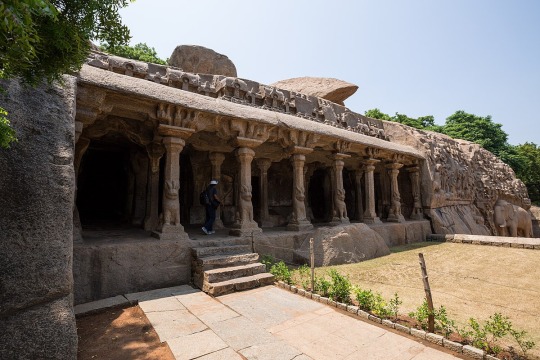
Krishna Mandapam at Mahabalipuram
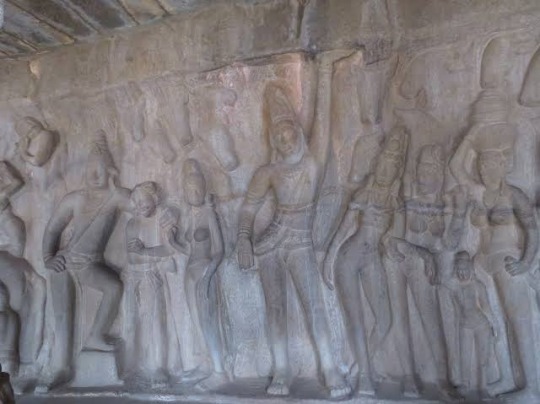
Krishnan lifting Govardhana, Balarama on the right side, consoling an old couple. Nappinnai on the left side gazing at him admiringly, holding the hands of his sister Subhadra.
Aditha Karikalan, Thirukkoilur Malayaman and Parthibendra Pallavan spend their night in this complex near the iconic Shore Temple, at the end of Book 1. The young princes discuss about sculptures and poetry, which Parthibendran finds distasteful. Malayaman leaves them to watch villu pattu in the Pancha ratha complex and it is here that Karikalan narrates the story of his heartbreak. Now it is a closed structure, but originally it was an open air bas relief. The mandapam enclosing it was constructed only in the 16th century, during Vijayanagara period.
An entire chapter (Achchiyar Kuravai) of Silappathikaram is about Nappinnai playing Kuravai dance with Krishan and Balaraman. Manimekalai (Sangham epic, not PS character) too mentions this dance. When Vanthiyathevan gives Aditha Karikalan's letter to Kundavai, Kundavai's retinue is seen dancing to this, singing about various asuras trying to kill Krishnan.
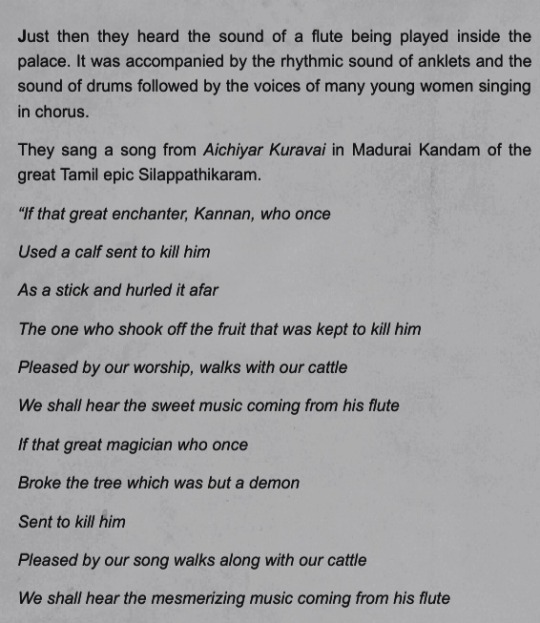
When Karikalan goes to Kadambur, there too we see the preparations for the Kuravai.
While having a heart to heart conversation (as much as someone like Nandini can open her heart), Nandini tells Manimegalai about her hallucinations. According to her, when we love or hate someone intensely, we can see and feel them even in their absence.
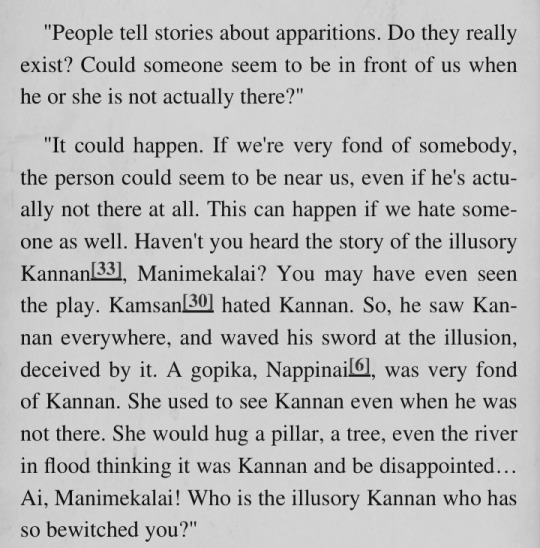
This is something Nandini made up for her consolation, because Nappinnai is never seperated from Krishna. In fact, it said that Vishnu left his divine wives and descended from his seat to be Nappinnai's beloved.
You parted from the eternal Great Flower [Lakshmi] and from the Lady Earth, became a youth, and then united in marriage with the shoulders of the cowherd Pinnai.
In Kuravai Koothu, women sing that Krishna avoids Lakshmi because he is so enamored by Nappinnai.
Is Pinnai of bangled arms so beautiful that He who had won great reputation by measuring the universe, would not look at Lakshmi dwelling in his own breast ?
It is to this Nappinnai that Andal prays to give her an opportunity to get one with Krishna, as her other attempts to wake him up were futile.


Nandini must have heard of the North Indian narratives about viraha unmadini (driven mad by seperation) Radha which were in their infancy then. Nappinnai didn't have the habit of seeing hallucinations - it is Nandini who has mental health issues.
This connection also shows Nandini's guilt about her life's circumstances though they were beyond her control. When Vanthiyathevan tells her that her Krishnan is still waiting for her, she replies that she doesn't deserve it. After marrying Periya Pazhuvettaraiyar, Nandini is never shown praying earnestly - either she is lying about different prayers and austerities or she is using devotion to avoid questions.
Edit: After writing the original post, I thought I will read Thirumangai Alwar's poems because his poetry is specifically mentioned in the chapter which shows Karikalan, Parthibendran and Malayaman going to the port to oversee the loading for goods for Arulmozhi's army. Look what I found:
Pinnai's forehead is a gleaming crescent moon So long ago in battle he subdued seven bulls for her hand And now he owns beautiful Kanchi which is surrounded by beautiful cool ponds of waters Where the sovereign of Pallavas who have the sharp blood stained sword in his hands Who owns a drum with a bitter mouth And the Conch with the roar of the sea Pays his obeisance to his Lord.
(The poem says that the poet's god is the Lord of Kanchi who is worshipped by the Pallava King. The rest are the descriptions of the the god and the king. In PS, crown prince Karikalan is ruling from Kanchi with Parthipendra Pallavan as his vasal)
Very subtle 🤣🤣
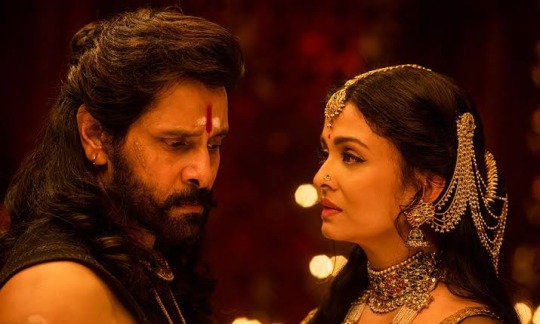
Are you even real, Maya Kanna?
@willkatfanfromasia @sowlspace @vibishalakshman @harinishivaa @thelekhikawrites @hollogramhallucination @thegleamingmoon @whippersnappersbookworm @nspwriteups @jukti-torko-golpo @arachneofthoughts @thirst4light
#ponniyin selvan#ponniyin selvan 2#aditha karikalan#nandini#nandhini#nandini x karikalan#kollywood#ps2#ps1
55 notes
·
View notes
Text
Of Slippers, Rings And Other Such Trinkets
Of Slippers, Rings And Other Such Trinkets

The philosopher Blaise Pascal once remarked, “Cleopatra’s nose, had it been shorter, the whole face of the world would have been changed.” Something tells me it wasn’t just the nose that would have changed the history of the world. A nose ring perhaps.
Just take a gander through history and literature and look at the havoc created by the various accessories women use to adorn themselves. Maybe it…
View On WordPress
#cinderella#desdemona#draupati#mahabharatha#othello#ramayana#sakuntala#shakespeare#silappathikaram#sita
0 notes
Text
Methil Devika’s ‘Kottichetham’ wins applause for it choreography and presentation as a duet
New Post has been published on https://jordarnews.in/methil-devikas-kottichetham-wins-applause-for-it-choreography-and-presentation-as-a-duet/
Methil Devika’s ‘Kottichetham’ wins applause for it choreography and presentation as a duet
Methil Devika has been not been resting on her laurels during the lockdown. The danseuse and academic has been busy with performances, classes and choreography. New themes and fresh interpretations, some of which were shared on social media, won acclaim for her interpretation and interesting perspectives that she translated into the vocabulary of classical dance.
Recently, ‘Kottichetham’, an excerpt of which was shared on her Facebook page, created ripples of excitement among dance buffs. Performed by Devika and Dr Arun Azeez, the video of the recital was launched by singer KS Chitra on her Facebook page.
“This is an excerpt from the Tamil epic Silappathikaram, written by Ilango Adigal. Kottichetam is believed to have been danced by the Parayur Chakyan of the Chera court for the King and the queen. The Chera King had just emerged victorious from a battle and the image of the king and the queen together inspired him to dance this piece,” explains Devika.
She adds that Kottichetham is the dance of Lord Siva and Uma, a part of himself. While Siva’s eyes are blazing and his matted locks are tossed around, the Uma within him is the picture of composure. “The pointers in the lines are definitely towards the Ardhanareeswara concept and talks about the twirl of energy between the divine masculine and the feminine within one self and not two persons,” she elaborates.
Set to music by the late Kavalam Narayana Panicker and Kavalam Srikumar in Champa tala, a tala native to Kerala’s art forms, Kottichetham was choreographed by Devika 10 years ago.
In January 2020, Devika had conducted a dance workshop for international students. Kottichetham was one of the pieces she had taught at the workshop. One of the participants was Melbourne-based ENT surgeon Dr Arun Azeez. “Almost 32 years ago, Arun had bagged the first prize for Mohiniyattam at the Kerala State Youth Festival competition. Now, a busy medical practitioner, Arun is more into painting. The workshop caught his attention and he decided to explore the aspects of Mohiniyattam once more. I was amazed to find him getting into the groove without many difficulties. He picked up the steps within six days and that is how Kottichetham was performed recently,” says Devika.
Television director Rajesh Kadamba visited her Kalari in Palakkad when the workshop was in progress. When he saw the performance, Rajesh was keen on archiving it. Despite Devika’s initial reluctance, Arun also felt that it must be recorded as he had no idea when he would be able to come to India again. Given the present circumstances, Devika feels it was a good idea to have archived it.
New path
Pleased with the reception to the video, Devika says the whole experience has opened a new path for her as she plans to explore the dynamics of the dance form for a male genre. “I am working on many items that suit the male energy for the dance form. I feel it will push the boundaries of the art form,” asserts Devika who cherishes dancer-actor Vineeth Radhakrishnan’s compliments for the piece.
Moreover, she points out that as soon as they had finished the preliminaries of the workshop, she had an intuition that Arun would come into his own with ‘Kottichetham’.
Although she had composed it for a solo and had danced at prestigious venues in India, she says the dynamics of a duet came as a pleasant surprise. “We improvised a lot but it came out well,” she says.
Delving into the roots of the piece, she recalls that this particular part of the Tamil epic was not very familiar to many practitioners of music and dance.
“According to anthropologists, Parayur Kootu Chakyan must be from the present-day Paravur. The Chera King in those parts may have inspired the Chakyan to come up with this piece. Kavalam sir had told me that ‘Kottichetham’ mean a dance accompanied by clapping of hands. Later, I happened to read that it also signifies a moment when these two entities, the feminine and the masculine, cannot be distinguished despite their dualities. That is yet another interpretation of Kottichetham.
“However, Kavalam sir’s description is also correct. When I narrated the background and performed this in Chendamangalam, near Paravur, one of the priests of a temple there told me that there was an offering in some Siva temples there that involved clapping and laughing. Known as ‘Kottum Chiriyum’, it was performed only by women,” she explains. The priest told her that her recital reminded him of that offering.
Devika, completely bowled over by the antiquity of the piece, goes on to add that it is still a work in progress.
Notwithstanding the fact that she had no plans to release it, Devika says the pandemic has highlighted how unpredictable life has become and so she decided to share it with the world.
“Kottichetham has been performed by other dancers as well, including veteran Kanak Rele. But each person has approached it from a different perspective. In this case, it is the duet that changed the entire presentation of the piece,” she says with a laugh.
However, Devika believes that certain portions of the dance need to be improved upon.
“For me, Ardhanareeswara is not being half male and half female. That is more of an artist’s impression. More than two people dancing, I felt that it pointed to the presence of the male and female in every person. It is an interaction of energies within oneself. You have to be in union with yourself to be in the same bandwidth as another person who is also in union with himself/herself. Only then will the Ardhanareeswara concept achieve fullness,” avers the dancer and guru.
Source link
0 notes
Text
Google Maps in Silappathikaram?
Well, not exactly. But, a similar turn-by-turn directions were given in that 1500+ years old Tamil epic all right. ————————————————————————————-
Before you proceed to read this, be warned it’s toasted in Tamil literature and land. Read the note at the bottom to know more. —————————————————————————–
I wasn’t going around looking for this. We were listening to carnatic music by M.S. and there…
View On WordPress
0 notes
Link
via Today Bharat When Indira Gandhi announced the Emergency in 1975, among the few Chief Ministers of the country who opposed her was Tamil Nadursquo;s Muthuvel Karunanidhi. His supporters say that despite having political control of the state, he took a stand against the draconian act and the despotic Maintenance of Internal Security Act (MISA), and stood by democracy. It cost him dearly ndash; his government was dissolved soon, and his confidantes and family members faced the wrath of Indira's government. He would not return to power for nearly 13 years. But those years defined him as the brave, shrewd and perseverant person he was, until the very end of his life. On August 7, the master politician and Dravidian luminary who held five terms as the CM of the state, passed away in Chennai, not before a long and hard battle against his own body. The ailing leaderrsquo;s mortal remains are at Kauvery Hospital, where he had been receiving treatment since July 28. The veteran politician had been keeping unwell and was out of active politics for nearly two years. His public appearances had also become limited. In December 2016 alone, he was hospitalised twice, and since then had been in and out of the hospital. Following the deterioration in his health, his son MK Stalin wasnbsp;namednbsp;the Working President of the party on January 4, 2017 at a meeting of the DMKrsquo;s general council in Chennai. Ill-health prevented Karunanidhi from attending the event, the first time ever he missed it due to his health. Karunanidhi, however, continued to hold the post of President till his death.nbsp; nbsp; From Thanjavur to Fort St. George Karunanidhi wasnbsp;bornnbsp;on June 3, 1924 at Thirukkuvalai in erstwhile Thanjavur district of Tamil Nadu, around 300 km from state capital Chennai. He was born into anbsp;poornbsp;Isai Vellalar family ndash; members of a temple-dependent caste that traditionally played the Nadaswaram. While his fathernbsp;wantednbsp;him to propagate the familyrsquo;s musical tradition, Karunanidhi was not inclined. But it was the music classes that gave Karunanidhi his first lessons in politics, as it reflected the caste intricacies of that era. He was not allowed to cover his upper body and his learning was restricted to a few songs. At the age of 14, Karunanidhi was inspired by a speech made by Alagiriswamy of the Justice Party in 1932, which prompted him to enter politics. He became a student activist in Periyarrsquo;s Self-Respect Movement, whichnbsp;foughtnbsp;for the rights of the Dravidians against the domination of the lsquo;Aryanrsquo; north Indians. The 1937 anti-Hindi agitations catapulted him into the thick of Dravidian movement, and elevated his profile in the state. After Hindi was made compulsory in schools, Periyar brought to the forefront inspiring young Tamil students to take to the streets in protest. Among the students leading the protest was Karunanidhi, who gave speeches and even brought out a magazine. His political activism found favour with Periyar and his lieutenant CN Annadurai, who gave him political space. Both of them were also impressed with his excellent oratorical skills and gave him the opportunity to address public gatherings. He was later made the editor of the Dravidar Kazhagam party magazine, Kudiyarasu. He led campaigns fighting for the rights of Dravidians and this brought him into political prominence in Tamil Nadu in the 1950s and 1960s. After Independence, after Periyarrsquo;s movement split in two, Karunanidhi joined the faction led by Annadurai, who went on to form the DMK in 1949. While Karunanidhi was good at mobilising crowds, he also managed to raise funds for the party. He was first elected to the Tamil Nadu Assembly from the Kulithalai seat of Tiruchirapalli district in 1957. He was among 15 DMK legislators elected. Thereafter in 1961, he was appointed the DMK Treasurer, and a year later, he became the Deputy Leader of Opposition in the state Assembly. He got a cabinet berth in 1967 when he was made the Minister for Public Works and Highways, after the DMK formed the government. Following the death of CN Annadurai in 1969, he became the CM of Tamil Nadu with the help of MG Ramachandran, known popularly as MGR. In 1971, he led the party to a resounding victory in the snap elections held that year. The very next year, after a cabinet post was denied to him, MGR split from DMK and formed his own party, the AIADMK. Political rivalry in later years Karunanidhirsquo;s government was dismissed in 1976 by then PM Indira Gandhi, who imposed Presidentrsquo;s rule in the state, following a declaration of Emergency in the country. In the 1977 elections, the AIADMK led by MGR trounced the DMK and stayed in power for as long as he was alive. Only after MGRrsquo;s death in 1989, did the DMK stage a comeback and Karunanidhi became CM for a third time after a gap of 13 years. However, an unsavoury event on March 25, 1989 turned the tide against Karunanidhi. On that day, Jayalalithaa, the Leader of the Opposition and the first woman in the state to occupy that post, was assaulted in the Tamil Nadu Legislative Assembly. The DMK minister for Public Works, Duraimurugan was at the centre of the controversy, as he allegedly tugged at her saree, which tore in the process. This incident altered the political dynamics of the state. In early 1991, the Centre dismissed the DMK government and Karunanidhi suffered a humbling defeat in the elections held in June. The government in Tamil Nadu alternated between the two Dravidian parties every five years, until the last Assembly election in 2016 which Jayalalithaa managed to win, for a second successive term in office. An important reason for the loss of DMK in 2011 Assembly polls was the corruption allegations against his party and family, most notably the 2G spectrum scam in 2008. The CBI arrested several people in connection with the scam, including DMK member and former telecom minister A Raja and Karunanidhirsquo;s daughter Kanimozhi. Both were subsequently acquitted. Karunanidhi perceived the 2G investigations against DMK members as part of a grand plan by the Congress to dump the party. Vinod Jose for Caravannbsp;reportedthat Karunanidhi had in fact confided to his closest associates that Sonia Gandhi was planning to betray the party, just like her mother-in-law had done several decades back. After Indira won a landslide victory in the general elections of 1971, Karunanidhi felt that she abandoned the DMK and associated with MGR who had left the DMK, in order to gain a stronger foothold for the Congress in Tamil Nadu. Life beyond politics Outside his political life, he was a prolific scriptwriter in the Tamil film industry. He was popular for writing historical stories which furthered the rationalist ideals of the Dravidian movement. He started his writing career with the film Rajakumari in 1947 and this was also the first time that MGR and him were seen together onscreen. Many early MGR films like Abimanyu, Manthiri Kumari, Marutha Naattu Ilavarasi, Naam and Pudhumai Pithan had script and dialogues written by Karunanidhi. Some of his early plays included Manimagudam, Ore Ratham, Thooku Medai, Vellikizhamai, Udhayasooriyan and Silappathikaram. In 2009, a Tamil film, Pen Singham, which had script written by Karunanidhi based on his old novel, was released. In 2010, he wrote his 75th script titled Ilaingan, based on which a film was released later. On the personal front, he married twice and had six children. From his first wife Padmavati, he had a son Muthu. His second wife was Dayaluammal from whom he had sons MK Alagiri, MK Stalin, Thamizharasu and a daughter Selvi. He also had a daughter, Kanimozhi, from his partner Rajathiammal.
0 notes
Text
Suruli falls
Suruli Falls are about 56 kms from Theni. Suruli Falls are also known as Chinna Suruli or Cloud Land Falls. The nearest known place from Suruli Falls is the Kombaithozhu Village. Originating in Meghamalai or Periyar Mountain Range, the Suruli Falls drops from a height of 150 feet gathering in a pool. From the pool these falls plummets to a depth of 40 feet surrounded by lush greenery.
Lying on the way to Periyar Wildlife Sanctuary, the Suruli Falls are a perfect place for outing. The beauty of the falls increases with its surroundings. With the dense forest all over, the wild flowers and fruits add charm to the route of the falls. The sounds of the falling fall can be heard from the road which leads to the Falls. Reaching here is adding life to the excursion. Suruli Falls are so beautiful that they have even been mentioned in the Tamil Epic Silappathikaram written as poem.
Around Suruli Falls
Kailasanathar Cave Temple
This temple is situated 800 meters above the fall and has a spring. This spring is supposed to have curative powers. It is thought if one stands inside the spring, the waters of the spring cures most of the diseases. There are 18 Rock Cut Architecture Caves around the temple which are worth seeing.
Thousand Lingam Temple
Suruli Velappar Temple
Suruli Velappar Temple in praise of Kartikeya is located near the falls. This temple is shaped like an OM Pranava. OM is the source mantra of the universal. This Mantra was generated before the Earth and all planets were created. At this cave one can hear the OM Mantra when you are in meditation frequency. This statement was told by Omgara guru Sidhar Gunaneethy, who is the founder of Rishi’s Meditation.
The Dargah
The Dargah at Suruli is an important worship place for some Muslims. This is named after Abubacker Masthan who lived around 1630s in this area and is buried here.
Sunset at Narasimha Parvata
Narasimha Parvata
Narasimha Parvata is the tallest peak in the surroundings with a depth of 3780 feet. The trekking to Narasimha Parvata begins from Mallandhur Village . The route to Narashimha Parvata is not very dense but has several trees which are as high as 40 to 50 high. It takes approx. three hours to reach the Parvata or Hill. The sight from the Hills is panaromic.
Meghamalai
This is the place for Coffee Plantations or rather one of the best places around to see and be in Coffee Plantations. If you are in South India then you are bound to see Coffee Plantations and this is the nearest place around.
Meghamalai
Festival
The Tamil Nadu Tourism Department celebrates summer festival at Suruli falls every year.Construction of a bridge across the Suruli River at a cost of Rs.45 lakhs has increased tourist flow to the falls significantly.
Best Time To Visit
Suruli Falls are round the year Falls but June to October is the best time to be here as there is a lot of greenery. This is also the time when the water of the Falls at its best with full volume of water flowing in it.
Some Tips
Chenna Suruli Falls are best seen in the month of June when there is the SUMMER FESTIVAL held by the Tamilnadu Government. However, if you want to enjoy the falls in silence, then the rest of the months are best. However, Suruli Falls can be visited throughout the year.
Suruli Falls are on the way to Periyar Wildlife Sanctuary. So if you going to see the National Park, then take time out to see the Falls too.
In and around the Falls there are no snacks bounties, so its better if you take them along.
If there are kids with you, hold their hands all the time. The Falls are quite deep and there is no way out. It rains heavily in the rainy season, so take along umbrellas or raincoat. You can also hire them for a few days. Do not litter around. You have to pay fine if you do so
How To Get There By Air Theni does not have an airport, and the nearest airport is Madurai, at a distance of 76 kms from Theni. Madurai is connected to 2 other Indian cities. The airlines servicing Madurai are Air India, Air India-IC, Go Air, Go Business, IndiGo, Jet Airways Konnect, Jet Airways, JetLite, Kingfisher Red, Kingfisher and SpiceJet. By Rail A number of railway tracks link Theni to most of the cities and regions of Tamil Nadu. Theni is also the main route for the tourists traveling from Madurai to Kochi via Bodinayakanur and Munnar and from Madurai to the Thekkadi wildlife sanctuary. By Road Theni is well-connected to a number of neighboring cities by an efficient network of roads. The roads connecting Theni are well-maintained and comfortable which help in adding an extra dash of fun if you are planning a tour to Theni.
Accommodation
Theni is home to a number of hotels and resorts, all of which are fully equipped to provide warmth and hospitality to all the guests to the city. These include several hotels pertaining to the economy and choice of numerous people on a tour to Theni.
Photo Gallery
Suruli falls
Thousand Lingam Temple
Sunset at Narasimha Parvata
Meghamalai
Suruli Falls- Theni Suruli Falls are about 56 kms from Theni. Suruli Falls are also known as Chinna Suruli or Cloud Land Falls.
#Kailasanathar Cave Temple#Meghamalai#Sunset Narasimha Parvata#SURULI FALLS#Suruli Velappar Temple#TAMILNADU#The Dargah#THENI
0 notes
Text
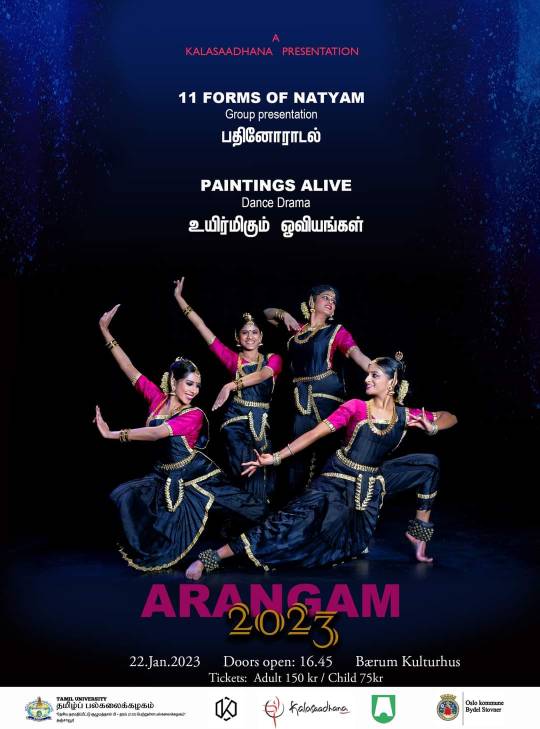
#Kalasaadhana#Event#Kavitha Laxmi#Norway#Bharathanatyam#11 forms of dance#Silappathikaram#Madhavi#Paintings Alive#Paintings#Ravi Varma#Dance Drama#Ooviyam#Natanam#Natampuri#Classical
1 note
·
View note
Photo
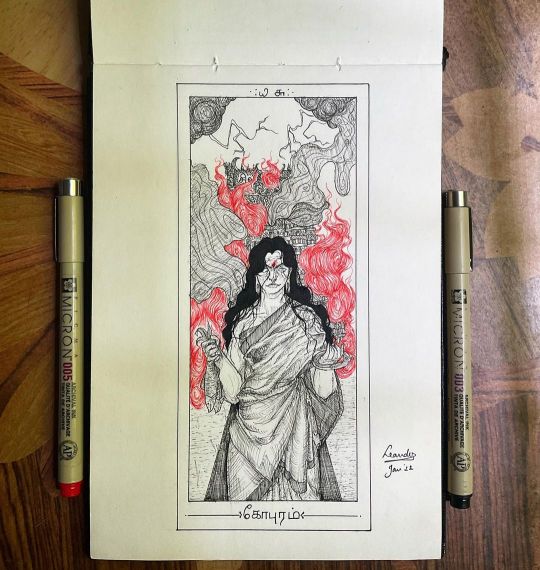
“கோபுரம்”/“Gopuram” (“The Tower”) “என்காற் சிலம்புபகர்தல் வேண்டி நின்பாற் கொலைக்களப் பட்ட கோவலன் மனைவி கண்ணகி யென்பதென் பெயரேயெனப்…” -சிலப்பதிகாரம் (62-64) Featuring the most iconic Tamil classical literary figure of all time- Kannagi from Ilangovadigal’s Silappadhikaram, here we have “The Tower” card ✨ (lmao I guess we’re making this a series after all💀). Drawing the Madurai Meenatchi Amman Temple (the one featured here is the West Gopuram) was definitely a task, but honestly it’s amazing how intricate the architecture is. Really loved incorporating the symbols of the silambu and the two dead fish representing the death of the Pandya King Nedunchezhiyan and Queen Kopperundevi. Oh and இனிய தமிழ் மரபு திங்கள் நல்வாழ்த்துக்கள் to all our Canadian Tamizh siblings!!! (Ik I’m late sorry 😩) #leanderscribbles #tamil #tamizh #tamizhar #tamilart #tamilartist #art #artist #tamilliterature #madurai #kannagi #silappathikaram #manimegalai #sangam #sangamliterature #symbolism #literature #lineart #blackandwhite #tarot #tarotcards #tarotart #tattooart #wicca #pagan #divination #occult #explore #instagram https://www.instagram.com/p/CYTCOhNBY9N/?igshid=NGJjMDIxMWI=
#leanderscribbles#tamil#tamizh#tamizhar#tamilart#tamilartist#art#artist#tamilliterature#madurai#kannagi#silappathikaram#manimegalai#sangam#sangamliterature#symbolism#literature#lineart#blackandwhite#tarot#tarotcards#tarotart#tattooart#wicca#pagan#divination#occult#explore#instagram
0 notes